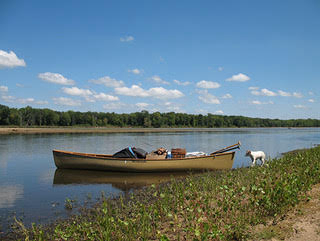
|
MADISON - Efforts to improve water quality throughout the Wisconsin River basin continue to move forward with Environmental Protection Agency (EPA) approval of the Wisconsin River Basin Total Maximum Daily Load (TMDL) plan. The approved TMDL plan aims to reduce phosphorus in a vast area of Wisconsin spanning the central corridor and covering more than 9,100 square miles.
"The TMDL represents a framework for implementation but improved water quality will not happen overnight and will require a long-term commitment from citizens living and working in the basin along with support from local, state and federal governments." said Pat Oldenburg, a DNR water resource engineer and implementation manager of the project.
The Wisconsin River is a popular recreational resources. The Total Maximum Daily Load (TMDL) study will provide a strategic framework and prioritize resources for water quality improvement in the Wisconsin River Basin.Photo credit: DNR
The plan approved April 26 was developed over the course of many years through partnership with stakeholder groups and the EPA. Everything from collecting water quality samples to evaluating water quality models involved a wide variety of partners working with the department including county land and water conservation departments, Petenwell and Castle Rock Stewards, UW-Stevens Point and modeling experts from HDR, Inc. The plan involves a series of calculations that represent the amount of phosphorus that the waters can handle and still meet state water quality goals. Development of these calculations is required for impaired waterways under the federal Clean Water Act as part of efforts to meet applicable water quality standards.
"DNR fully recognizes the challenges in achieving these reductions and has already started partnering with representatives from local government, agriculture, and citizens groups to develop focused, locally-led implementation efforts in specific watersheds," said Oldenburg, DNR water resource specialist.
Detailed analysis determined that some waterbodies in the basin require site-specific phosphorus standards, including two of the largest reservoirs on the Wisconsin River, Petenwell and Castle Rock Flowages, where the water quality problems were the primary motivation for the development of the TMDL. Separate rules for those waterbodies are expected to be adopted later this year.
The Wisconsin River basin study area encompasses or touches portions of 22 counties. The basin has 109 stream and river segments and 38 lakes or reservoirs that are currently listed as impaired due to elevated levels of phosphorus.
A copy of the EPA approved TMDL plan can be found by visiting dnr.wi.gov and searching for "Wisconsin River Basin TMDL."